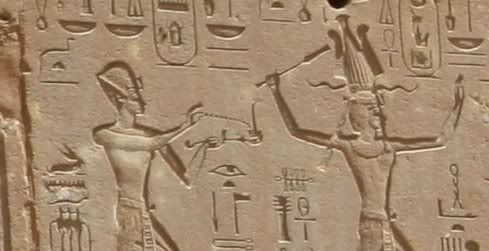 |
| Thutmose III and Hatshepsut (via Wikipedia) |
Recently the Public Radio Station in Boston had a one hour discussion on one of the rare female pharoah’s of Egypt — Hatshepsut (1479 to 1458 B.C.E.) — who ruled 150 years before Akhenaten, the monotheist pharoah. National Geographic had a cover story as well.
Though a woman, in one temple carving she is shown born as a boy. She would also walk in a striding pose, like males instead of keeping the legs close together, like other Egyptian women. Some statues depicted her with a beard. It was as if she was trying to convince the world that she was male. Her motivation for doing so is known.
Her mummy was discovered almost a century back, but remained unidentified. She was called KV60a.
KV60a had been cruising eternity without even the hospitality of a coffin, much less a retinue of figurines to perform royal chores. She had nothing to wear, either —no headdress, no jewelry, no gold sandals or gold toe and finger coverings, none of the treasures that had been provided the pharaoh Tutankhamun, who was a pip-squeak of a king compared with Hatshepsut.
And even with all the high-tech methods used to crack one of Egypt’s most notable missing person cases, if it had not been for the serendipitous discovery of a tooth, KV60a might still be lying alone in the dark, her royal name and status unacknowledged. [The King Herself]
Hatshepsut was not the first woman to rule Egypt, but she ruled more than all other women — for 21 years. She erected four granite obelisks at the temple of Karnak. This animation takes the viewer from eastern Karnak across the sacred lake to the shrine of Thutmose III, who would succeed Hatshepsut.
After her death, around 1458 B.C., her stepson went on to secure his destiny as one of the great pharaohs in Egyptian history. Thutmose III was a monument maker like his stepmother but also a warrior without peer, the so-called Napoleon of ancient Egypt. In a 19-year span he led 17 military campaigns in the Levant, including a victory against the Canaanites at Megiddo in present-day Israel that is still taught in military academies. He had a flock of wives, one of whom bore his successor, Amenhotep II. Thutmose III also found time to introduce the chicken to the Egyptian dinner table.
In the latter part of his life, when other men might be content to reminisce about bygone adventures, Thutmose III appears to have taken up another pastime. He decided to methodically wipe his stepmother, the king, out of history. [The King Herself]
While Egypt had other female Pharoah’s, it was believed that Caanan had only male rulers. But now a recently found plaque depicts an image of the first female “king” of the region.
The plaque itself depicts a figure dressed as royal male figures and deities once appeared in Egyptian and Canaanite art. The figure’s hairstyle, though, is womanly and its bent arms are holding lotus flowers — attributes given to women. This plaque, art historians suggest, may be an artistic representation of the “Mistress of the Lionesses,” a female Canaanite ruler who was known to have sent distress letters to the Pharaoh in Egypt reporting unrest and destruction in her kingdom. [Was A ‘Mistress Of The Lionesses’ A King In Ancient Canaan?]
This lady, a contemporary of Akhenaten, is displayed in male iconography as well. she is dressed as a male and archaeologists think she too ruled as a king.
See Also: Hatshepsut gallery in National Geographic, Digital Karnak: Animations from UCLA of the Karnak temple.